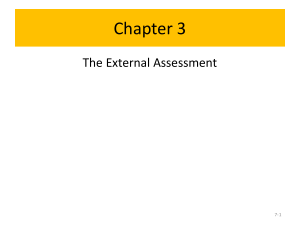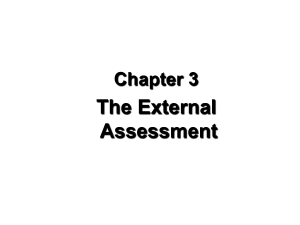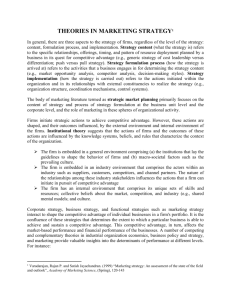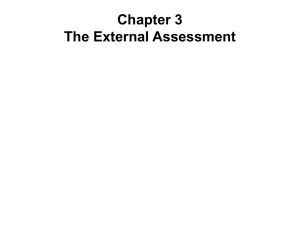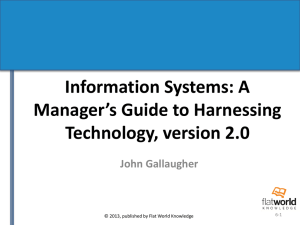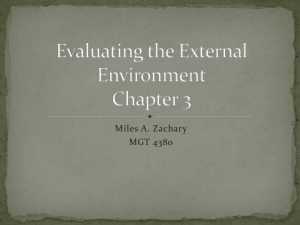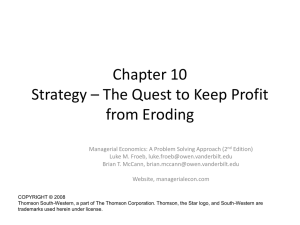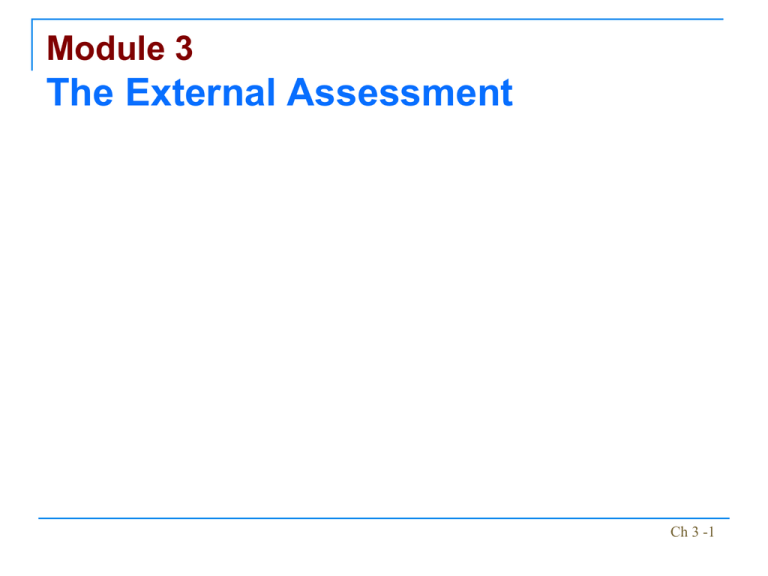
Module 3
The External Assessment
Ch 3 -1
Ch 3 -2
External Assessment
“It is not the strongest of the species that
survive, nor the most intelligent, but the one
most responsive to change.”
– Charles Darwin
“Nothing focuses the mind better than the
constant sight of a competitor who wants to
wipe you off the map.”
– Wayne Calloway, Former CEO, PepsiCo
Ch 3 -3
External Strategic
Management Audit
– Environmental
Scanning
– Industry Analysis
Ch 3 -4
External Strategic
Management Audit
Identify & evaluate factors beyond the
control of a single firm
Increased foreign competition
Population shifts
Aging society
Fear of traveling
Stock market volatility
Ch 3 -5
External Strategic
Management Audit
Purpose of an External Audit
Develop a finite list of
opportunities
that could benefit a firm
threats that should be avoided
Ch 3 -6
Ch 3 -7
External Audit
Gather competitive intelligence
Assimilate information
Evaluate
Resulting in a list of the most
important key external factors
Ch 3 -8
Performing External Audit
Long-term Orientation
External
Factors
Measurable
Applicable to
Competing Firms
Hierarchical
Ch 3 -9
Industrial Organization
(I/O) View
Industry factors are more important
than internal factors
Performance determined by industry
forces
Ch 3 -10
I/O Perspective Firm Performance
Industry Properties
Economies of Scale
Barriers to Market Entry
Product Differentiation
The Economy
Level of Competitiveness
Ch 3 -11
Economic Forces
GDP
Trends in the dollar’s value
Unemployment rates
Ch 3 -12
Ch 3 -13
Social, Cultural, Demographic, and
Natural Environmental Forces
Major Impact –
•Products
•Services
•Markets
•Customers
Ch 3 -14
Social, Cultural, Demographic, and
Natural Environmental Forces
US Facts
Aging population
Less White
Widening gap between rich & poor
2025 = 18.5% population > 65 years
2075 = no ethnic or racial majority
Ch 3 -15
Social, Cultural, Demographic, and
Natural Environmental Forces
Facts
World population 7 billion
World population = 8 billion by 2028
World population = 9 billion by 2054
U.S. population > 310 million
Ch 3 -16
Social, Cultural, Demographic, and
Natural Environmental Forces
Trends
More American households with
people living alone
Aging Americans – affects all
organizations
Ch 3 -17
Political, Governmental, and
Legal Forces
Government Regulation
Key opportunities & threats
Antitrust legislation
Tax rates
Lobbying activities
Patent laws
Ch 3 -18
Political, Governmental, and
Legal Forces
Protectionist policies
Governments taking equity stakes
in companies
Ch 3 -19
Technological Forces
Major Impact –
•Internet
Ch 3 -20
Technological Forces
Significance of IT
•Chief Information Officer (CIO)
•Chief Technology Officer (CTO)
Ch 3 -21
Technological Forces
Essential for nearly every
strategic decision
Ch 3 -22
Competitive Forces
Collection & evaluation of data on
competitors is essential for successful
strategy formulation
Ch 3 -23
Competitive Forces
Identify Rival Firms’
•Strengths
•Weaknesses
•Capabilities
•Opportunities
•Threats
•Objectives
•Strategies
Ch 3 -24
Competitive Forces
Competition in virtually all
industries can be described as
intense
Ch 3 -25
Key Questions Concerning
Competitors
Their strengths
Their weaknesses
Their objectives and strategies
Their responses to external variables
Their vulnerability to our alternative
strategies
Our vulnerability to strategic counterattack
Ch 3 -26
Key Questions Concerning
Competitors
Our product/service positioning
Entry and exit of firms in the industry
Key factors for our current position in industry
Sales/profit ranking of competitors over time
Nature of supplier and distributor
relationships
The threat of substitute products/services
Ch 3 -27
Competitive Forces
7 characteristics of most competitive firms
Market share matters
Understanding what business you are in
Broke or not, fix it
Innovate or evaporate
Acquisition is essential to growth
People make a difference
No substitute for quality
Ch 3 -28
Competitive Intelligence
A systematic and ethical process for
gathering and analyzing information
about the competition’s activities and
general business trends to further a
business’s own goals
Ch 3 -29
Sources of Competitive Intelligence
Internet
Employees
Managers
Suppliers
Distributors
Customers
Creditors
Consultants
Trade journals
Want ads
Newspaper articles
Government filings
Competitors
Ch 3 -30
Objectives of Competitive Intelligence
Provide a general understanding of industry
and competitors
Identify areas where competitors are
vulnerable and assess impact of actions on
competitors
Identify potential moves that a competitor
might make
Ch 3 -31
Market Commonality
The
number and significance of
markets that a firm competes in
with rivals
Ch 3 -32
Resource Similarity
Extent
to which the type and
amount of a firm’s internal
resources are comparable to a
rival
Ch 3 -33
The Five-Forces Model of Competition
Ch 3 -34
Steps to Determine if an Acceptable
Profit Can Be Earned
1.
2.
3.
Identify key aspects or elements of each
competitive force
Evaluate how strong and important each
element is for the firm
Decide whether the collective strength of
the elements is worth the firm entering or
staying in the industry
Ch 3 -35
The Five-Forces Model
Rivalry among competing firms
Most powerful of the five forces
Focus on competitive advantage of
strategies over other firms
Ch 3 -36
Conditions that Cause High Rivalry
Among Competing Firms
High number of competing firms
Similar size of firms competing
Similar capability of firms competing
Falling demand for the industry’s products
Falling product/service prices in the
industry
Ch 3 -37
Conditions that Cause High Rivalry
Among Competing Firms
Consumers can switch brands easily
Barriers to leaving the market are high
Barriers to entering the market are low
Fixed costs are high among firms
competing
The product is perishable
Ch 3 -38
Conditions that Cause High Rivalry
Among Competing Firms
Rivals have excess capacity
Consumer demand is falling
Rivals have excess inventory
Rivals sell similar products/services
Mergers are common in the industry
Ch 3 -39
The Five-Forces Model
Potential Entry of New Competitors
Barriers to entry are important
Quality, pricing, and marketing can
overcome barriers
Ch 3 -40
The Five-Forces Model
Potential development of substitute
products
Pressure increases when:
Prices of substitutes decrease
Consumers’ switching costs
decrease
Ch 3 -41
The Five-Forces Model
Bargaining Power of Suppliers is
increased when there are:
Large numbers of suppliers
Few substitutes
Costs of switching raw materials is high
Backward integration is gaining control or
ownership of suppliers
Ch 3 -42
The Five-Forces Model
Bargaining power of consumers
Customers being concentrated or
buying in volume affects intensity of
competition
Consumer power is higher where
products are standard or
undifferentiated
Ch 3 -43
Conditions Where Consumers Gain
Bargaining Power
If buyers can inexpensively switch
If buyers are particularly important
If sellers are struggling in the face of falling
consumer demand
If buyers are informed about sellers’
products, prices, and costs
If buyers have discretion in whether and
when they purchase the product
Ch 3 -44
Sources of External Information:
Unpublished Sources
Customer surveys
Market research
Speeches at professional or shareholder
meetings
Television programs
Interviews and conversations with
stakeholders
Ch 3 -45
Sources of External Information:
Published Sources
Periodicals
Journals
Reports
Government documents
Abstracts
Books
Directories
Newspapers
Manuals
Ch 3 -46
Sources of External Information:
Web Sites
http://marketwatch.multexinvestor.com
http://moneycentral.msn.com
http://finance.yahoo.com
www.clearstation.com
https://us.etrade.com/e/t/invest/markets
www.hoovers.com
Ch 3 -47
Forecasting Tools and Techniques
Forecasts are educated assumptions
about future trends and events
Quantitative techniques – most
appropriate when historical data is
available and there is a constant
relationship
Qualitative techniques
Ch 3 -48
Assumptions
Estimates of future events based
upon the best available
information in the present
Ch 3 -49
Industry Analysis: The External
Factor Evaluation (EFE) Matrix
Economic
Social
Cultural
Demographic
Environmental
Political
Governmental
Technological
Competitive
Legal
Ch 3 -50
EFE Matrix Steps
1.
2.
3.
4.
5.
List key external factors
Weight from 0 to 1
Rate effectiveness of current strategies
Multiply weight * rating
Sum weighted scores
Ch 3 -51
Ch 3 -52
Ch 3 -53
Industry Analysis EFE
Total weighted score of 4.0
Organization response is outstanding to threats
and weaknesses
Total weighted score of 1.0
Firm’s strategies not capitalizing on opportunities
or avoiding threats
Ch 3 -54
Industry Analysis: Competitive Profile
Matrix (CPM)
Identifies firm’s major competitors and
their strengths & weaknesses in
relation to a sample firm’s strategic
positions
Critical success factors include
internal and external issues
Ch 3 -55
Ch 3 -56
Industry Analysis CPM
Important –
Just because one firm receives a 3.2 rating
and another receives a 2.8 rating, it does not
follow that the first firm is 20 percent better
than the second.
Ch 3 -57
All rights reserved. No part of this publication may be reproduced, stored in a
retrieval system, or transmitted, in any form or by any means, electronic,
mechanical, photocopying, recording, or otherwise, without the prior written
permission of the publisher. Printed in the United States of America.
Ch 3 -58


